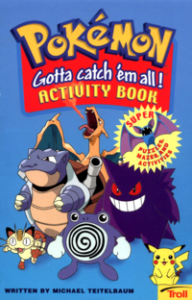Marketing Childhood
Listen to the Recess! Clip
| Author | John Cech |
| Air Date | 12/29/1999 |

Marketing Childhood Transcript
It seems that each week, in major newspapers or magazines, someone is doing an article about how much money is to be made on the merchandise of childhood. This fall alone, we’ve had the Harry Potter books phenomenon — a story that always seemed to end in how many copies were being sold and (with the film deal) how much money its author, Joanne Rowling, had made on the reading bonanza she had started.
Then we were besieged by Pokemon– the 154 cards, the television show, the video games, the movie, the gum, the candy, the action figures, the key chains, the racks and racks of Pinkachotchkes that have been carefully planned to outlast the usual year and a half to three years of a fad toy’s shelf-life. That means, of course, adding new pocket monsters to collect (the slogan of Pokemon is, after all, “Gotta catch ’em all, “) it means attracting new audiences of kids as the old ones move on, generation after generation, if you expect to stay in the game, teasing five or six billion dollars out of the pockets of children and their families every year–for decades.
According to one estimate, advertisers will spend about 12 billion dollars this year alone to sell Pokestuff and many other child-related products, and one of the niche jobs that will make this merchandise irresistibly adorable, are a small, highly paid group called Baby Wranglers, who are skilled at drawing melting performances from their diminutive diCaprios and Diazes. As Patricia Winters Lauro puts it in her recent article on the subject in the New York Times, “An awful lot is riding on the tiny shoulders that the wranglers try to keep in line.”
And then there are the 27 million tweens that Newsweek featured in a cover story a few months ago. We used to call them pre-teens, those older kids between childhood and adolescence but now they have been given a catchy name and, in the elaborately labeled pictures of Tween boys and girls and their rooms, a marketing diagram of their likes and dislikes in clothing, musical groups, movie and sports stars. After all, we’re told in the article, “tweens had direct influence over $ 128 billion in family spending in 1997.”
Well, I probably shouldn’t be bringing any of this flabbergasting stuff up after the holidays, when we’ve all been influenced, directly or indirectly, and more than we’d probably care to admit by tweens, wrangled babies, and little yellow monsters with funny names. I’m done.